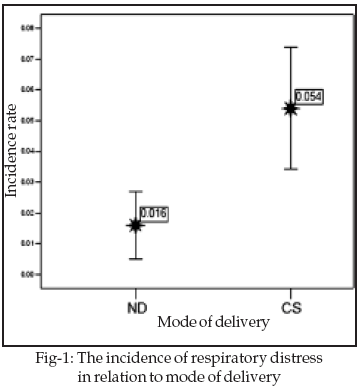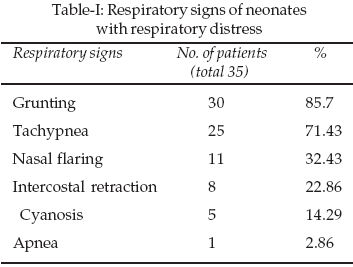|
|
||||
|
Published by : PROFESSIONAL MEDICAL PUBLICATIONS |
||||
|
ISSN 1681-715X |
||||
|
||||
|
- |
||||
|
ORIGINAL ARTICLE |
||||
|
- |
||||
|
Volume 24 |
July - September 2008 |
Number 4 |
||
|
|
||||
|
||||
|
|
||||
|
Published by : PROFESSIONAL MEDICAL PUBLICATIONS |
||||
|
ISSN 1681-715X |
||||
|
||||
|
- |
||||
|
ORIGINAL ARTICLE |
||||
|
- |
||||
|
Volume 24 |
July - September 2008 |
Number 4 |
||
|
|
||||
|
||||
Influence of mode of delivery at term on
the neonatal respiratory Morbidity
Masoud Dehdashtian1, Ehsan Riazi2, Mohammad Hasan Aletayeb3
ABSTRACT
Objective: Respiratory morbidity is an important complication of elective cesarean section. Our objective was to find out the incidence of respiratory distress in term neonates delivered by elective cesarean section and compare it with neonates delivered vaginally.
Methodology: We evaluated one thousands infants delivered by elective cesarean section and normal vaginal delivery for respiratory distress.
Results: Among 500 cesarean done, 27 (5.4%) neonates had respiratory distress and among 500 vaginal delivery infants, 8(1.6%) developed respiratory Distress (P<0.001).
Conclusions: The odd ratio for neonatal respiratory distress was 3.38, almost threefold higher in cesarean section group than those delivered vaginally.
KEY WORDS: Cesarean delivery, Term infant, Neonatal respiratory Distress, Transient Tachypnea of Newborn, Catecholamine, Fetal lung Fluid.
Pak J Med Sci July - September 2008 Vol. 24 No. 4 556-559
How to cite this article:
Dehdashtian M, Riazi E, Aletayeb MH. Influence of mode of delivery at term on the neonatal respiratory Morbidity. Pak J Med Sci 2008;24(4):556-9.
1. Masoud Dehdashtian,
Neonatologist, Assistant Professor,
Ahwaz Jondi Shapur University of Medical Science,
Emam Khomeini Hospital, Ahwaz – Iran.
2. Ehsan Riazi,
General Physician,
Ahwaz Jondi Shapur University of Medical Sciences,
3. Mohammad Hasan Aletayeb,
Assistant Professor,
Ahwaz Jondishapur Bahman Cheraghian,
Ahwaz Jondishapur University of Medical Science,
Ahwaz – Iran.
Correspondence
Masoud Dehdashtian
E-mail: m.dehdashtian@gmail.com
* Received for Publication: February 11, 2008
* Accepted: June 27, 2008
INTRODUCTION
Respiratory morbidity is an important complication of elective cesarean section (ECS) in term infants.
1-4 The incidence of respiratory distress was reported in 6% of newborns delivered by ECS,5 versus 1% in Infants born vaginally.6 The presence of labor preceding cesarean section reduce the risk of respiratory morbidity in the neonatal period.2,3 The aim of this study was to determine the incidence of respiratory distress in term neonates delivered by ECS in relation to neonates delivered vaginally.METHODOLOGY
We did a prospective epidemiological cross – sectional study from May 2006 to November 2006 in private and governmental hospitals of Ahwaz, the center of khozestan province of Islamic republic of Iran. In this study a neonate was considered term if delivery was performed after the end of 37 weeks of first day of last menstrual period, a cesarean section was assumed elective if infants delivered by scheduled surgery and before the onset of labour. Vaginal delivery was supposed normal if the onset of labour was spontaneous, singelton, there was no complication of pregnancy and instrumentation. Furthermore, mothers with diabetes mellitus, chronic hypertension, preeclampsia, addiction, renal failure, hemoglubinopathies, heart failure, isoimmunization, multiple gestation, induction, or meconium stained amniotic fluid were excluded.
The infants born by elective cesarean section or vaginal delivery at two academic and two private medical centers were evaluated for respiratory distress during the first day of life. The newborns who needed greater than 40% oxygen concentration were referred to neonatal intensive care unit of Imam Khomeini Hospital of Ahwaz. Data was extracted from charts of mothers and their infants. We estimated that with consideration of 6% Incidence of respiratory distress after ECS at 37 weeks gestation, and 1% after vaginal delivery, 204 deliveries per group was needed. To enhance the value of the study we evaluated 500 deliveries per group. The data were analyzed by SPSS 13. Fisher exact test, chi square test were applied where appropriate. P value, odd ratio and 95% Confidence Interval (CIs) were calculated. A value of P<0.05 was considered significant. The study was approved by the research ethics committee of Ahwaz Jondishapour University of medical science.
RESULTS
The incidence of respiratory morbidity was 5.4% (NO. 27) in infants delivered by ECS and 1.6% (NO. 8) in normal vaginal delivery infants (P<0.001) (Fig-1).

The odd ratio for respiratory distress in ECS group Was 3.38 (CI 1.55 – 7.36). Respiratory signs and clinical diagnosis of neonates with respiratory distress are shown in Table-I.

Eighteen (2.66%) of the neonates with respiratory distress in cesarean group, and three infants (37.5%) in vaginal delivery group needed oxygen concentration greater than 40% and were admitted to neonatal intensive care unit (P= 0.001), (OR: 3.6; CI 1.35 -9.6). Two infants with respiratory distress who delivered by ECS needed mechanical ventilation but none of the vaginal delivery group (P= 0.5). The mean duration time of admission was four day in cesarean and three days in vaginal delivery group infants. An infant with respiratory distress in ECS group died due to persistent pulmonary hypertension of newborn. There was no death in vaginal delivery group, but one of them was discharged with diagnosis of hypoxic ischemic encephalopathy. The relation between route of delivery and respiratory distress syndrome, persistent pulmonary hypertension of newborn and hypoxic ischemic encephalopathy was evaluated (P=1). The relation between route of delivery and need for admission to neonatal intensive care unit was significant (P=0.001), (OR: 6.33; CI 1.89 –21.3). There was no significant relation between delivery route and mortality rate (P=1).

DISCUSSION
In our study the incidence of respiratory morbidity in term neonates following ECS increased significantly compared with vaginal delivery. These results are in agreement with previous findings.
7,8 Previous studies suggests that significant respiratory morbidity in term cesarean deliveries may be the result of iatrogenic prematurity.9 In our study, respiratory distress of the newborn was prevalent, despite the exclusion of poorly dated pregnancies and deliveries less than 37 weeks. In this study the incidence of respiratory morbidity in term infants born vaginally was 1.6%, which is similar to previous study.2,3Labor and delivery enhance neonatal lung adaptation. An explanation for this finding is possibly that labor and delivery induce a surge of catecholamines in the fetus,
10 which is important for postnatal lung adaptation.11 Infants born vaginally have higher catecholamine concentration at birth than infants born by ECS.12 Catecholamines stimulate the absorption of fetal lung fluid, inhibit secretion of fetal lung fluid, and increase the release of surfactant.13 Infants born by elective cesarean section has a less pronounced perinatal catecholamine surge than infants born vaginally, possible cause being the absence of labor.7 However, there are lot of studies that show ECS increases the respiratory morbidity in term infants and the prevalence of cesarean delivery has increased dramatically in Islamic Republic of Iran during the past decade.14-16 The increased rate of ECS result in a considerable number of neonate who need respiratory support, a diagnostic workup predisposing to additional morbidity and separation of the baby from the mother and probably increasing neonatal mortality rate.CONCLUSIONS
The decision to undergo elective cesarean delivery appear to have negative impact on immediate neonatal outcome. Improvement of prenatal care and fetal monitoring toward reducing of gynecologist fear of perinatal Asphyxia, discussion of benefits of vaginal delivery for pregnant women and dangers of cesarean section for neonate and maternal well- being would be effective in reducing the rate of elective cesarean section.
ACKNOWLEDGEMENT
We thank Dr. Afzeli, Dr. Ahmadzade, Dr. Monajemzade and Dr. Emami Moghadam for referring patients’ for the study.
REFERENCES
1. Dani C, Reali M, Bertini G, Mechmann L, Spangnolo A, Tangucci M, et al. Risk factors for the development of respiratory distress syndrome and transient tachypnea in newborn Infants. Eur Respiratory J 1999;14(1):155-9.
2. Hales KA, Morgan MA, Thurnau GR. Influences of labor and route of delivery on the frequency of respiratory morbidity in neonates. Int J Gynecol Obstet 1993;43(1):35-40.
3. Morrison JJ, Rennine JM, Milton PJ. Neonatal respiratory morbidity and mode of delivery at term: Influence of timing of Elective Cesarean Section. Br J Obstet Gynecol 1995;102(2):101-6.
4. Graziosi GC, Bakker CM, Brouwers HA, Bruinse HW. Elective Cesarean Section is preferred after the completion of a minimum of 38 weeks of Pregnancy. Ned Tijdschr Geneeskd 1998;(17):142:2300-3.
5. Jain L, Dudell GG. Respiratory transition in infants delivered by cesarean section. Semin perinatology 2006;30(5):269-304.
6. Levine EM. Ghai V, Barton JJ, Storm CM. Mode of delivery and risk of respiratory disease in newborns. Obstet Gynecol 2001;97(3):439-45.
7. Beydoun H, Yunis KA, Khogali M, Usta I, Tamim H. Cesarean route of delivery and hyaline membrane disease. A Hospital based Case – control study in Greater Beirut. Pediat and Perinatal Epidemiology 2003;17(4):308-63.
8. Gerten KA, Coonrod DV, Boy CR, Curtis Bay, Chambliss LR. Cesarean delivery and respiratory distress syndrome. Does labor make a difference? Amer J Obstet Gynocol 2005;193(3):1061-4.
9. Yang JY, Fang LJ, Tsou Yau KH. Labor pain before elective cesarean section reduces neonatal respiratory distress. Zhonghua Min Guo Xiao Er Ke Yi Xue Hui Za Zhi 1997;38(1):38-43.
10. Mehandru PL, Assel BG, Nuamah IF, Fanaroff AA, Kalhan SC. Catecholamine response at birth in preterm new borns. Biol Neonate 1993;64(2-3):82-8.
11. Kauffman KS, Seidler FJ, Slotkin TA. Prenatal dexamethasone exposure causes loss of neonatal hypoxia tolerance: cellular mechanisms. Pediatr Res 1994;(3595):515-22.
12. Wang L, Zhang W, Zhao Y. The study of maternal and fetal plasma catecholamine levels during pregnancy and delivery. J Perinat Med 1999;27(3):195-8.
13. Lines A, Nardo L, Phillips ID, Possmayer F, Hooper SB. Alteration in lung expansion affect surfactant protein A, B and cm RNA level in fetal sheep. AM J Physiol 1999;276(2 pt 1):l239-45.
14. Moghareh Abed L, Goharian V, Ghanei M. Cesarean section rate and its indication in IR of IRAN in 1988. Hakim Medical J 1988;3(2):147-54.
15. Shariat M, Majlesi F, Azari S. Cesarean Section in maternity Hospital in Tehran, Iran. Payesh J Iran Inst Health Sci Res www.iranmedex.com 1381;3(1): 5-10.
16. Borghei NS, Borghei S, Gol Alipoor MJ. A study of related factors on the mode of delivery. Scientific Med J Ahwaz Uni Med Sci 1384;440:51-60.
HOME | SEARCH | CURRENT ISSUE | PAST ISSUES
Professional
Medical Publications
Room No. 522, 5th Floor, Panorama Centre
Building No. 2, P.O. Box 8766, Saddar, Karachi - Pakistan.
Phones : 5688791, 5689285 Fax : 5689860
pjms@pjms.com.pk